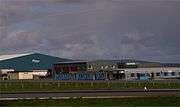Scatsta Airport
Scatsta Airport (IATA: SCS, ICAO: EGPM), was a commercial airport on the island of Mainland, Shetland in Scotland located 17 nautical miles (31 km; 20 mi) north of Lerwick[1] and 5 mi (8.0 km) southwest of Sullom Voe Terminal.
Scatsta Airport | |||||||||||
|---|---|---|---|---|---|---|---|---|---|---|---|
 Terminal buildings | |||||||||||
| Summary | |||||||||||
| Airport type | Public | ||||||||||
| Operator | Serco UK and Europe on behalf of BP | ||||||||||
| Serves | Shetland | ||||||||||
| Elevation AMSL | 81 ft / 25 m | ||||||||||
| Coordinates | 60°25′58″N 001°17′46″W | ||||||||||
| Map | |||||||||||
 EGPM Location in Shetland | |||||||||||
| Runways | |||||||||||
| |||||||||||
| Statistics (2018) | |||||||||||
| |||||||||||
Scatsta Aerodrome has a CAA Ordinary Licence (Number P777) that allows flights for the public transport of passengers or for flying instruction as authorised by the licensee (BP Exploration Operating Company Limited).[2]
The airport will close on 30 June 2020.[3]
History
The airport was first developed in 1940 as RAF Scatsta, a Royal Air Force fighter plane base to support Coastal Command flying boat operations at RAF Sullom Voe, and was the most northerly base in the British Isles.
Construction started in Spring 1940, of two runways. One was 1,400 yd (1,300 m) long on a heading of 130 degrees and the other was 1,510 yd (1,380 m) long on a heading of 250 degrees. The first runway was completed in April 1941. The main contractor for the construction of the aerodrome was the Zetland County Council.
In November 1944 Scatsta was used as a support base and diversion point for Lancasters from squadron 617, the famous "Dam Busters", led by Wing Commander J. B. Tait, on Operation Catechism, which bombed and sank the Tirpitz near Håkøy Island, Tromsø.
After World War II Scatsta Aerodrome lay dormant except for the landing of a US Coast Guard HC-130 Hercules on 24 May 1969, in connection with the LORAN navigation station which had been established at the north west end of runway 13/31.
It was abandoned after World War II, but reinstated as a civilian airport in 1978 to support the Shetland oil industry, and the Sullom Voe oil terminal in particular.
Flights
As of August 2018, Scatsta is the sixth largest airport in Scotland, ranked by international passengers.[4] This classification may be on the basis of helicopter flights to and from oil rigs in the Norwegian and/or Faroes sectors of the North Atlantic/North Sea oil region, or some classification of flights to foreign-registered (though UK-crewed and serviced) oil rigs as being "foreign" destinations. The only fixed wing route operating regularly from Scatsta is the 7 or 8 times daily shuttle to and from Aberdeen, to ferry offshore crew to Scatsta for onward travel via helicopter to oil rigs, and also mainland workers at the Sullom Voe Terminal commonly working either a 2-week on/off shift or 10 days on 4 days off rota.
The balance between oil service flights and "civilian" flights can be judged from the fact that the airport service area has no bar (the nearest is some 3 mi (4.8 km) away), no taxi or bus service (to anywhere), and three large rooms for helicopter passengers to don their survival suits before embarking.
The first flight of the day from Scatsta to Aberdeen has no passengers from offshore – and can have anything up to about 60 passengers during the height of the season, although the figure is more commonly between 15 and 25 on an average day. It is operated by Eastern Airways using ATR 72 aircraft.
The airport has recently undergone significant upgrades as increasing investment has been provided to support the North Sea offshore rigs. This has seen the airport have a new Control Tower Building (CTB) that went live on 28 January 2013. This upgrade will also include a new Terminal building and possibly Distance Measuring Equipment (DME) to runway 06.
Closure
On 4 March 2020, Scatsta airport announced that it would be closing its doors to the public during the summer for the foreseeable future, with a loss of up to 50 jobs in and around the airport.[5] Flights from Scatsta will be relocated to Sumburgh.
See also
- List of airports in the United Kingdom
- List of Royal Air Force stations
- List of former Royal Air Force stations
References
- Scatsta - EGPM
- Civil Aviation Authority Aerodrome Ordinary Licences
- https://www.ch-aviation.com/portal/news/91314-scatsta-uk-to-close-in-late-2q20
- UK Airport Statistics: EU and Other International Terminal Passenger Traffic August 2018. Accessed 2 November 2018
- Scatsta Airport Closure Shetland Times